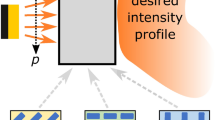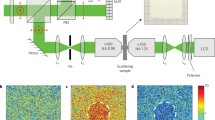Abstract
We investigate numerically how to control and reduce power-dependent walk-off by using a three-dimensional model for beam propagation in highly nonlocal bias-free nematic liquid crystals (NLCs). We consider beam propagation with different initial momenta and rest angles. Owing to the highly nonlocal character of the dielectric response of NLC, we demonstrate various beam trajectories. We show that it is possible to practically eliminate walk-off in real NLCs by properly choosing the angle of incidence.
Similar content being viewed by others
Avoid common mistakes on your manuscript.
1 Introduction
An important characteristic of many nonlinear media is nonlocality, which strongly affects the propagation of beams through the medium. It tends to improve the stability of beams, because of the diffusion mechanism in the underlying nonlinearity. When the characteristic size of the response is much wider than the size of the excitation, a highly nonlocal situation emerges in nonlocal nonlinear media. In nematic liquid crystals (NLCs), both experiments (Henninot et al. 2006; Hutsebaut et al. 2005) and theoretical calculations (Beeckman et al. 2004) demonstrated that the nonlinearity is highly nonlocal.
On the other hand, NLCs are highly anisotropic media. The tensor nature of the refractive index of the nematic medium, as well as the transverse modulation instability in an (anisotropic) NLC cell, produce power-controlled angular steering of light filaments (Whitham 1974; Peccianti and Assanto 2005). The angle between the Poynting vector and the wave vector of the extraordinary polarized beam is referred as the walk-off angle. Power-dependent walk-off was investigated in details in Piccardi et al. (2010a, b), but extremely big discrepancy between experimental data and numerical results has been obtained.
Here we demonstrate how to control and reduce power-dependent walk-off by using a three-dimensional model for beam propagation in highly nonlocal bias-free NLCs. Our numerical results show that it is possible to practically eliminate walk-off in NLCs by properly choosing the angle of incidence (initial momenta in numerics) for the given rest angle.
2 The model
We start from the nonlocal nonlinear three-dimensional (3D) scalar model for the wave propagation in uniaxial NLCs accounting for the walk-off. In this model, the optical beam propagates in the z direction, while the NLC molecules can rotate in the x-z plane only; for the full three dimensional description see, for example Sala and Karpierz (2012). The modeled liquid-crystal cell of interest is sketched in Fig. 1. The system of equations (in the steady-state) consists of the nonlinear Schrödinger-like equation for the propagation of the optical field E (extraordinary polarized), and of the diffusion equation for the molecular orientation angle \(\theta\) in the absence of bias (Piccardi et al. 2010a, b):
where \(k_0\) is the wave number in the vacuum, \(D_x\) and \(D_y\) are the modified diffraction coefficients, and \(\alpha\) is the absorption coefficient. The dielectric anisotropy is \(\varepsilon _a=n_e^2-n_o^2\), with \(n_e\) and \(n_o\) being the extraordinary and ordinary refractive indices, respectively. K is Frank’s elastic coefficient in the single constant approximation. The superscript (p) indicates a quantity calculated at the beam peak (at any z). The total orientation of the molecules with respect to the z axis is denoted as \(\theta (x,y,z)\), whereas angle \(\theta _0\) is the initial director orientation. The quantity \(\hat{\theta }=\theta -\theta _0\) corresponds to the optically induced molecular reorientation. The walk-off angle \(\delta\) is given by the relation:
where \(\varepsilon _\bot = n_o^2\). The extraordinary refractive index is \({n_e^2(\theta ) = \frac{\varepsilon _\bot (\varepsilon _\bot + \varepsilon _a) }{\varepsilon _\bot + \varepsilon _a \cos ^2(\theta )}}\) and \(n_0 = n_e(\theta _0)\). The anisotropic diffraction coefficients are \({D_x = \frac{ \cos ^4(\delta _0) \varepsilon _\bot ( \varepsilon _\bot + \varepsilon _a)}{ \varepsilon _\bot ^2 + \varepsilon _a ( 2 \varepsilon _\bot + \varepsilon _a) \cos ^2(\theta _0) }}\) and \({D_y = \frac{ \cos ^2(\delta _0) \varepsilon _\bot }{ \varepsilon _\bot + \varepsilon _a \cos ^2(\theta _0) }}\) (Conti et al. 2005). For nematic liquid crystal 6CHBT the refractive indices are \(n_e=1.6718\) and \(n_o=1.5225\), which gives \(\varepsilon _\bot =2.318\) and \(\varepsilon _a=0.477\). For \(\theta _0=75^{\circ }\) the linear walk-off angle is \(\delta _0 = 2.904^{\circ }\), and the diffraction coefficients are \(D_x=1.164\) and \(D_y=0.984\).
After the scaling of coordinates \(x/x_0\rightarrow x\), \(y/x_0\rightarrow y\), \(z/z_0 \rightarrow z\), where \(x_0\) is the transverse scaling length and \(z_0 = k_0 n_0 x_0^2\), the following model equations in the computational domain are obtained:
where we introduce an abbreviation \(\beta _1=k_0^2 x_0^2\) and also scaled the optical field intensity \(|E|^2 \frac{\varepsilon _{0}}{2Kk_0^2} \rightarrow |E|^2\). In all calculations the following data are kept constant: the propagation distance L = 1.5 mm, the laser wavelength \(\lambda = 1064\,\hbox {nm}\), the elastic constant \(\hbox {K} = 8.5 \cdot 10^{-12}\,\hbox {N}\), the absorption coefficient \(\alpha = 5\,\hbox {cm}^{-1}\).
3 Numerics
For complicated nonlinearities, numerical methods are necessary. In our calculations we used data corresponding to typical experimental conditions, and propagate Gaussian beams numerically. Split-step beam propagation procedure based on the fast Fourier transform is applied to the propagation of the optical field. The diffusion equation for the optically induced molecular reorientation is treated using the successive overrelaxation method, until convergence is achieved. Numerical procedure is explained in more details in Refs. Aleksić et al. (2012) and Petrović et al. (2013). In highly nonlocal nonlinear media, due to the nature of physical interaction, the input Gaussian and other beams slow converge to soliton-like beams during propagation. In numerics, the initial momentum in the inverse space (which causes an additional beam deflection) determines the angle of incidence: to obtain straight line propagation one assumes zero absorption and in this manner can easily calculate this angle.
4 Results
Optical beams propagating in reorientational media can be steered, owing to nonlinear changes in the walk-off angle \(\delta\), which presents the angle between Poynting vector and the wavevector of the extraordinary polarized beam. The linear walk-off angle \(\delta _0\) as a function of the rest angle is presented in Fig. 2. It is evident from the graph that for a given initial director orientation, walk-off changes are the largest for \(\theta _0\) close to 0 and \(\pi /2\). On the other hand, the nonlinear response becomes negligible for \(\theta _0=0\) and \(\theta _0=\pi /2\) and is maximum for \(\theta _0\approx \pi /4\).
Beam trajectories in the observation plane \(z-x\) for three characteristic values of \(\theta _0\) (\(15^{\circ }\), \(45^{\circ }\) and \(75^{\circ }\)) are presented in Fig. 3. We also varied the angle of incidence; for each curve the corresponding angle is indicated on the graph. We see that we can control power-dependent walk-off: we choose the beam direction by simply changing the angle of incidence.
Beam trajectories from numerics in the observation plane \(z-x\), for several different values of the angle of incidence, and for three characteristic values of \(\theta _0\). For all the cases presented, the beam power is \(P=30\,\hbox {mW}\) and the absorption coefficient is \(\alpha = 5\,\hbox {cm}^{-1}\)
Numerical results show that it is possible to practically eliminate power-dependent walk-off of solitons in NLCs by properly choosing the angle of incidence, for the given rest angle and beam power, see Fig. 4. For the cases presented, one can observe an undesired \(\pm 1\,\upmu {\mathrm{{m}}}\) beam-shift in the propagation plane, due to birefringent walk-off, over the propagation distance \(z = 1500\,\upmu {\mathrm{{m}}}\). For \(\theta _0 = 15^{\circ }\) the walk-off angle at \(z=0\) is \(\delta = 3.4^{\circ }\) but the best beam trajectory is for the launch angle equal to \(-3.0^{\circ }\); for \(\theta _0 = 45^{\circ }\) the initial walk-off angle is \(\delta = 4.5^{\circ }\), the best beam trajectory is for the angle of incidence equal to \(-4.65^{\circ }\); for \(\theta _0 = 75^{\circ }\) the initial walk-off angle is \(\delta = 2.1^{\circ }\), the best launch angle is \(-2.3^{\circ }\). The most rectified trajectories are in the region where walk-off changes are the smallest (\(\theta _0\approx \pi /4\)), although in this domain the walk-off angle is maximal.
The same as in Fig. 3, but now only the “best” beam trajectories are shown, i.e. the trajectories with the most reduced power-dependent walk-off
5 Conclusion
We investigated numerically the control and reduction of power-dependent walk-off by using a three-dimensional model for beam propagation in highly nonlocal bias-free NLCs. We presented beam propagation with different initial momenta and rest angles, and demonstrated various beam trajectories. Our numerical results show that it is possible to reduce walk-off in NLCs by properly choosing the angle of incidence.
References
Aleksić, N.B., Petrović, M.S., Strinić, A.I., Belić, M.R.: Solitons in highly nonlocal nematic liquid crystals: variational approach. Phys. Rev. A 85, 033826 (2012)
Beeckman, J., Neyts, K., Hutsebaut, X., Cambournac, C., Haelterman, M.: Simulations and experiments on self-focusing conditions in nematic liquid-crystal planar cells. Opt. Express 12, 1011–1018 (2004)
Conti, C., Peccianti, M., Assanto, G.: Spatial solitons and modulational instability in the presence of large birefringence: the case of highly nonlocal liquid crystals. Phys. Rev. E 72, 066614 (2005)
Henninot, J.F., Blach, J.F., Warenghem, M.: Experimental study of the nonlocality of spatial optical solitons excited in nematic liquid cristal. J. Opt. A Pure Appl. Opt. 9, 20–25 (2006)
Hutsebaut, X., Cambournac, C., Haelterman, M., Beeckman, J., Neyts, K.: Measurement of the self-induced waveguide of a solitonlike optical beam in a nematic liquid crystal. J. Opt. Soc. Am. B 22, 1424–1431 (2005)
Peccianti, M., Assanto, G.: Observation of power-dependent walk-off via modulational instability in nematic liquid crystals. Opt. Lett. 30, 2290–2292 (2005)
Petrović, M.S., Aleksić, N.B., Strinić, A.I., Belić, M.R.: Destruction of shape-invariant solitons in nematic liquid crystals by noise. Phys. Rev. A 87, 043825 (2013)
Piccardi, A., Alberucci, A., Assanto, G.: Soliton self-deflection via power-dependent walk-off. Appl. Phys. Lett. 96, 061105 (2010a)
Piccardi, A., Alberucci, A., Assanto, G.: Power-dependent nematicon steering via walk-off. J. Opt. Soc. Am. B 27, 2398–2404 (2010b)
Sala, F., Karpierz, M.: Modeling of light propagation and molecules alignment in nematic liquid crystals of planar orientation. Phot. Lett. Poland 4, 5–7 (2012)
Whitham, G.B.: Linear and Nonlinear Waves. Wiley, New York (1974)
Acknowledgments
This work has been supported by the Ministry of Science of the Republic of Serbia, under projects OI 171033, 171006 and III 45016, and by the NPRP 6-021-1-005 project of the Qatar National Research Fund (a member of Qatar Foundation). Authors acknowledge supercomputer time provided by the IT Research Computing group of Texas A&M University at Qatar. M.R.B. also acknowledges support by the Al Sraiya Holding Group.
Author information
Authors and Affiliations
Corresponding author
Additional information
This article is part of the Topical Collection on Advances in the science of light.
Guest Edited by Jelena Radovanovic, Milutin Stepić, Mikhail Sumetsky, Mauro Pereira and Dragan Indjin.
Rights and permissions
About this article
Cite this article
Petrović, M.S., Aleksić, N.B., Strinić, A.I. et al. Reduction of power-dependent walk-off in bias-free nematic liquid crystals. Opt Quant Electron 48, 157 (2016). https://doi.org/10.1007/s11082-016-0440-2
Received:
Accepted:
Published:
DOI: https://doi.org/10.1007/s11082-016-0440-2








